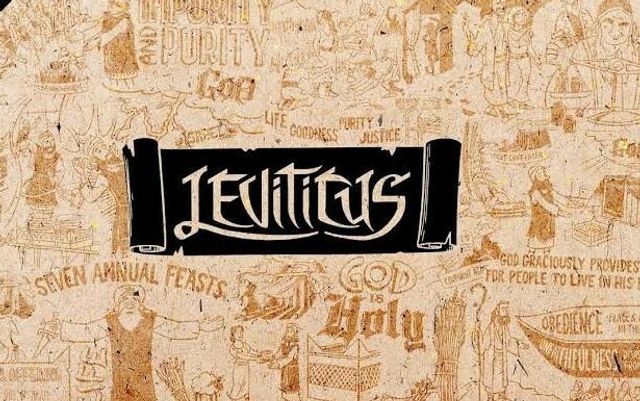
Hearing the Voice of God
Now the Lord called to Moses, and spoke to him from the tabernacle of meeting, saying (Leviticus 1:1)
The Tabernacle of Meeting was a place where God and man met each other.
The Bible says, “Out of the Tabernacle of Meeting God spoke to Moses”. This is significant because it tells us that out of the place of intimate fellowship, God will speak to a person.
The Tabernacle was completed (Exodus 40:33-34), and now God speaks from it, signalling His presence among His people.
“Speak to the children of Israel, and say to them: ‘When any one of you brings an offering to the Lord, you shall bring your offering of the livestock—of the herd and of the flock. (Leviticus 1:2)
Three major elements of the Mosaic Covenant:
- The Law (Exodus 20:1-21).
- Sacrifices for sin (Leviticus 1-7).
- The choice of blessing or curse (Deuteronomy 28).
you shall bring your offering of the livestock:
This meant that an Israelite worshipper could not offer a “wild” or non-domesticated animal. They could only bring domesticated livestock from the herd or from the flock.
3 If his offering is a burnt sacrifice of the herd, let him offer a male without blemish; he shall offer it of his own free will at the door of the tabernacle of meeting before the Lord.
- A male without blemish: Points to Christ, the perfect sacrifice. “but with the precious blood of Christ, as of a lamb without blemish and without spot.” (1 Peter 1:19).
- A Burnt Sacrifice or Burnt Offering: The burnt offering was fully consumed, symbolising total devotion to God. “I beseech[a] you therefore, brethren, by the mercies of God, that you present your bodies a living sacrifice, holy, acceptable to God, which is your [b]reasonable service.” (Romans 12:1).
- Meat was a rare luxury back then, so it was costly to burn an entire animal on the altar without giving any part of it to anyone but the Lord. This is exactly what happened with the burnt offering.
Burnt Offering
- All Male
- Skin for the Priest
- All Burnt on the altar
4Then he shall put his hand on the head of the burnt offering, and it will be accepted on his behalf to make atonement for him.
1.What Does "Putting His Hand on the Head" Mean?
The act of laying hands on the sacrificial animal was a symbolic transfer of guilt from the person offering the sacrifice to the animal.
The Hebrew verb used here for "put" (samakh) suggests pressing down with force, not a light touch. This emphasises a deliberate identification with the sacrifice.
By doing this, the sinner acknowledged that the animal was dying in his place.
2. The Concept of Substitutionary Atonement
The person bringing the offering deserved to die because of sin (Romans 6:23 – "The wages of sin is death.").
However, God allowed an innocent animal to take the punishment instead. This points to the principle of substitutionary atonement, which is fully realised in Lord Jesus Christ.
Isaiah 53:5-6 "The LORD has laid on Him the iniquity of us all." Just as the offerer’s sins were placed on the animal, our sins were placed on Christ.
5 He shall kill the bull before the Lord; and the priests, Aaron’s sons, shall bring the blood and sprinkle the blood all around on the altar that is by the door of the tabernacle of meeting.
The blood of the animal representing the life of the animal (Leviticus 17:11) – was sprinkled on the altar of sacrifice.
6 And he shall skin the burnt offering and cut it into its pieces.
This verse tells us that the animal had to be skinned before being burned on the altar. While this verse does not tell us what happens to the skin. Leviticus 7:8 tells us, “And the priest who offers anyone’s burnt offering—that priest shall have for himself the skin of the burnt offering which he has offered." The entire body of the animal was burned, but the skin was set apart for the priests.
7 The sons of Aaron the priest shall put fire on the altar, and lay the wood in order on the fire. 8 Then the priests, Aaron’s sons, shall lay the parts, the head, and the fat in order on the wood that is on the fire upon the altar; 9 but he shall wash its entrails and its legs with water. And the priest shall burn all on the altar as a burnt sacrifice, an offering made by fire, a sweet aroma to the Lord.
Notice the phrases, “lay the wood in order on the fire” and “shall lay the parts, the head, and the fat in order on the wood”
It seems to indicate that the priests could not be satisfied with simply piling wood or pieces of meat in bulk on the altar; they had to be arranged in the proper manner. This teaches us that God is a God of order, not disorder (1 Corinthians 14:40 – "Let all things be done decently and in order.").
A. Order Reflects Reverence for God
- Proper order showed respect for God’s instructions. Worship is not about what feels convenient but about following God’s ways.
- Example: Nadab and Abihu (Leviticus 10:1-2) were killed for offering "strange fire"—they did not follow God’s order.
B. Fire Must Be Prepared Before the Sacrifice
The fire had to be properly set before the offering was placed.
This reminds us of spiritual preparation before worship:
- Psalm 24:3-4 – "Who may ascend into the hill of the LORD? He who has clean hands and a pure heart."
- Before we offer our prayers and worship, our hearts must be properly prepared before God.
10 If his offering is of the flocks—of the sheep or of the goats—as a burnt sacrifice, he shall bring a male without blemish. 11 He shall kill it on the north side of the altar before the Lord; and the priests, Aaron’s sons, shall sprinkle its blood all around on the altar. 12 And he shall cut it into its pieces, with its head and its fat; and the priest shall lay them in order on the wood that is on the fire upon the altar; 13 but he shall wash the entrails and the legs with water. Then the priest shall bring it all and burn it on the altar; it is a burnt sacrifice, an offering made by fire, a sweet aroma to the Lord.
14 And if the burnt sacrifice of his offering to the Lord is of birds, then he shall bring his offering of turtledoves or young pigeons. 15 The priest shall bring it to the altar, [b]wring off its head, and burn it on the altar; its blood shall be drained out at the side of the altar. 16 And he shall remove its crop with its feathers and cast it beside the altar on the east side, into the place for ashes. 17 Then he shall split it at its wings, but shall not divide it completely; and the priest shall burn it on the altar, on the wood that is on the fire. It is a burnt sacrifice, an offering made by fire, a [c]sweet aroma to the Lord.
Three kinds of animals were offered as burnt offerings
- bulls (vv. 1–5)
- sheep and goats (v. 10)
- turtle-doves and pigeons (v. 14)
Only the rich could afford bulls, the “middle class” offered sheep or goats, as that was the most they could give, and the poor sacrificed turtle doves and pigeons.
In all cases, the offering was a real sacrifice.
Meat was a rare luxury back then, so it was costly to burn an entire animal on the altar without giving any part of it to anyone but the Lord. This is exactly what happened with the burnt offering.
God provided an option for the poor, showing that worship is not about wealth but willingness.
In Luke 2:24, Mary and Joseph offered turtledoves when presenting baby Jesus at the temple. Giving should reflect both our ability and heart (2 Corinthians 9:7).
Spiritual Application for Believers
- The burnt offering teaches total devotion—nothing was held back.
- Lord Jesus is the fulfilment of all sacrifices (Hebrews 10:10-12).
- God desires our best, not leftovers—our time, talents, and lives.
Join our WhatsApp Channel


Chapters
 3275
3275







